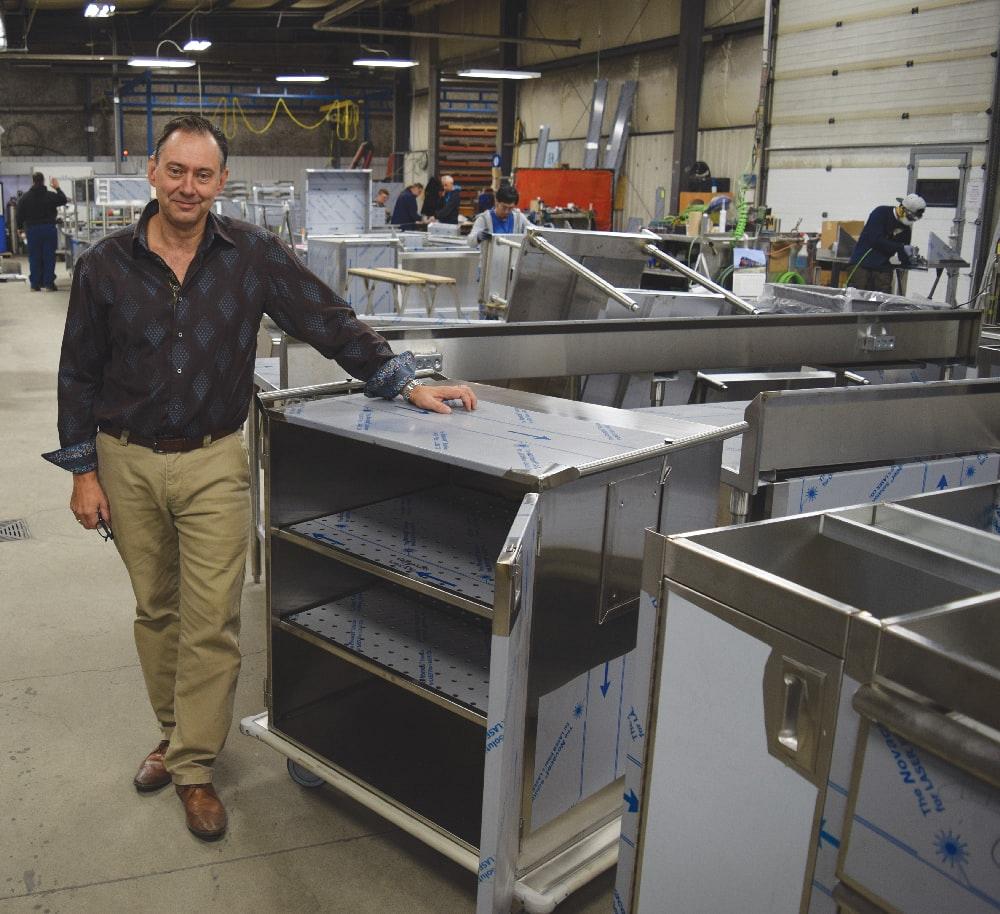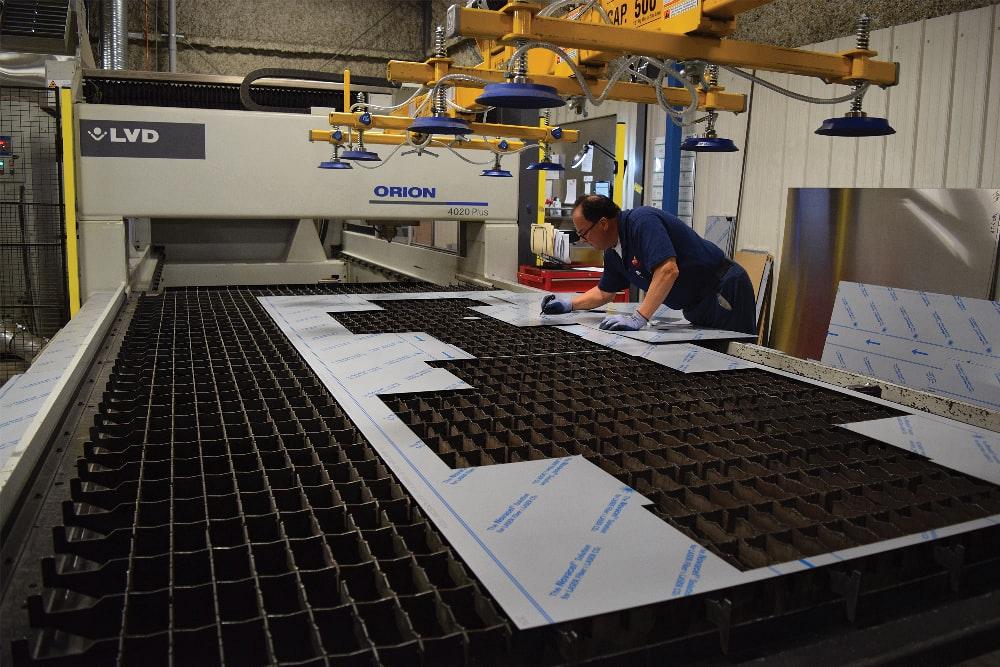Editor
- FMA
- The Fabricator
- FABTECH
- Canadian Metalworking
Halbar Stainless Products Ltd. grows with new facility, laser investment
Laser allows shop to speed production, diversify client base
- By Rob Colman
- January 17, 2017
- Article
- Fabricating

Trent Baird stands next to a medical cart the shop builds. Halbar receives orders for anywhere between six and over 150 of these carts at a time - an ideal product to run on an efficient laser cutting machine.
In the history of any business, there is usually a point when you decide to either get bought out by a larger company or aim to be that larger company yourself. That’s where Edmonton’s Halbar found itself over the past couple of years. In response, the family-run fabrication shop has set its sights on growth, purchasing a second shop in Kelowna and investing in a CNC laser to speed up production at its headquarters. In the process it has increased its production and its client base.
Over the past 42 years, Halbar has made a name for itself as Halbar Stainless, a custom fabrication shop focused primarily on industrial kitchens. The shop has been responsible for fitting out and installing industrial kitchens all over Canada and the U.S. – from retirement homes in Oregon and Hawaii to diamond mine camps in northern Canada.
But beyond that work, Halbar – run by brothers Dean and Trent Baird, sons of founder Cliff Baird – does much else as well, in a variety of metals. This work includes medical case carts for hospitals and other such assembled items. Primarily, based on its customer list, the work has been in stainless, but Trent Baird notes that the shop hopes to push well beyond that soon.
“We do work in pretty much any kind of metal,” he explained. “We just hired a new sales representative to try to get the word out and kick up some new business. The problem we’ve had in the past is the ‘Stainless’ in our name, so we’re trying to get out there as simply ‘Halbar’ now.”
The Baird family knows, of course, that stainless is still the heart of their operations. That’s why they bought Kelowna-based FinnTech, which is now known as Halbar Stainless Okanagan.
"This shop was a good fit for us,” said Baird. “The lower mainland is a burgeoning market for our customers, and it allows us to better serve them close to home.” The Kelowna facility has eight employees, and Dean Baird now oversees its operations. They are now adding 2,800 sq. ft. to the operation’s current 7,600 sq. ft.
The Edmonton headquarters is 20,000 sq. ft., 16,000 of which is used for production. There’s a team of 29 in the shop, and about 10 upfront.
Until the installation of the laser cutting equipment, Trent admitted that the Halbar shop was “old-school,” using shears, notchers, and hand-held plasma torches.
“We were and are a custom specialty shop. That was our concern with the laser: How does a custom shop justify buying a production piece of equipment?” said Baird. “We needed to change the way we think. Rather than thinking in terms of how we make the machine work for what we do, we had to think about how we can change the way we work to work with the machine. A sink is a sink, a table is a table. We are not creating something new every time we build something, we are simply modifying standard designs.”
Halbar purchased an LVD Orion 4020 Plus C02 laser from LVD Strippit in Akron, N.Y., through All Fabrication Machinery J.V. in Alberta, a company the shop has worked with regularly for the past 20 years for their machinery needs.
The laser cutter is a hybrid-style CO2 model engineered to process large sheets up to 4 by 2 meters. It is equipped with a high-pressure cutting head for clean cuts. A total power control feature automatically adjusts the laser power in relation to the cutting speed, ensuring an optimal cut and minimizing the heat-affected zone.
Halbar has an older Strippit turret punch that has worked very effectively for a number of years, so that was one of the reasons Baird considered an LVD laser. Then two years ago, Baird and his team visited L A Brayer Industries, another shop in Edmonton that uses an Orion laser.
“That visit was encouraging,” said Baird. “You want to have machines that others around you have so that if there are issues, if there’s knowledge that you need, you can turn to someone nearby.”
It was probably a visit to LVD Strippit’s facility in Akron that sealed the deal, though.
"We had a great meeting with Stefan Colle, LVD Strippit’s laser specialist,” said Baird. “He is very passionate about the LVD equipment, and I just saw a good fit for us in support and knowledge – and wanting to make this work for us.”
Baird said working with the laser has been a steep learning curve for the Halbar team, but the support from LVD and Elliott Matsuura’s LVD-dedicated support staff has been very positive.
“Whenever we need assistance, they are there to answer our questions,” said Baird.
Halbar currently has four people trained at differing levels on the laser. “I want to train another couple of people as well,” said Baird. “Having a few people cross-trained helps with succession planning.”
Jeff Dakin, the laser manager, has been impressed by what his team is able to do with the speed of the laser.
"We can create more intricate shapes with the laser and cut parts within parts easily,” Dakin explained. “It has also cut down on deburring and other finishing requirements.”
The purchase of the laser has somewhat changed the balance in the shop. Previously only three people worked upfront, with the balance on the shop floor. But growth in the past couple of years has meant training more people to do the CAD drawing work and adding a full-time CFO and comptroller to manage the continuing changes in the shop in Edmonton and Kelowna. Dean’s oldest daughter does CAD design and administrative work for the company, and his two sons work on the shop floor in Kelowna. Trent’s daughter is in sales support and IT in Edmonton.
With these and other re-organizations of staff, the Bairds now feel they can work more “for the company rather than ‘in’ the company.”
Stainless accounts for about 95 per cent of what Halbar is running on its laser machine right now. “We really want to use it for production-type parts eventually,” said Baird. “For instance, the medical carts we do would be ideal for the laser. Right now we get orders of anywhere between six and over 150. So this will be ideal for those large orders. With the custom jobs, it’s still a very effective solution, but none of our jobs allow for a lights-out scenario at this point.”
The company has already landed interesting new work, including cladding the escalators and stairs at Rogers Place, the new home of the Edmonton Oilers.
It’s the struggle to find qualified people in the industry that has Baird looking at more equipment.
“The young generation is very different,” he said. “People don’t work for companies, they work for themselves. How do we keep this generation engaged? By showing that there are possibilities to do things that are different from what we were doing before.”
Even though it doesn’t directly serve the oil and gas industry, Halbar is still affected by the market turbulence in the segment. For that very reason, further expansion is important to the company. Within five years, the Bairds hopes to be able to purchase a shop in Ontario to expand Halbar’s reach eastward.
With developments in both Edmonton and Kelowna growing the company’s bottom line, expect to see more changes from this western success story.
About the Author

Rob Colman
1154 Warden Avenue
Toronto, M1R 0A1 Canada
905-235-0471
Robert Colman has worked as a writer and editor for more than 25 years, covering the needs of a variety of trades. He has been dedicated to the metalworking industry for the past 13 years, serving as editor for Metalworking Production & Purchasing (MP&P) and, since January 2016, the editor of Canadian Fabricating & Welding. He graduated with a B.A. degree from McGill University and a Master’s degree from UBC.
Related Companies
subscribe now


Keep up to date with the latest news, events, and technology for all things metal from our pair of monthly magazines written specifically for Canadian manufacturers!
Start Your Free Subscription- Trending Articles
Aluminum MIG welding wire upgraded with a proprietary and patented surface treatment technology

CWB Group launches full-cycle assessment and training program

Achieving success with mechanized plasma cutting

Hypertherm Associates partners with Rapyuta Robotics

Brushless copper tubing cutter adjusts to ODs up to 2-1/8 in.

- Industry Events
MME Winnipeg
- April 30, 2024
- Winnipeg, ON Canada
CTMA Economic Uncertainty: Helping You Navigate Windsor Seminar
- April 30, 2024
- Windsor, ON Canada
CTMA Economic Uncertainty: Helping You Navigate Kitchener Seminar
- May 2, 2024
- Kitchener, ON Canada
Automate 2024
- May 6 - 9, 2024
- Chicago, IL
ANCA Open House
- May 7 - 8, 2024
- Wixom, MI

















